In a new world where intelligent agents can autonomously transfer funds and make decisions, Kite is building a full-stack trust infrastructure.
Original author: @0xPrismatic
Core Points
Currently, the vast majority of AI agents are still trapped in "sandbox mode." Due to a lack of necessary underlying infrastructure, they cannot engage in large-scale transactions, payments, or collaborations. This is akin to the most advanced self-driving cars being forever stuck in a parking lot, unable to truly hit the road.
Kite is working to build a complete technology stack to break this deadlock: a Layer 1 blockchain and developer platform designed specifically for agents, with built-in trust, payment, and collaboration mechanisms at runtime. Its innovative "Agent Passport" system grants agents verifiable identities, clear spending limits, and operational boundaries. Smart contracts efficiently handle key aspects such as fund custody, service level agreements (SLA), and dispute resolution.
Since the launch of the testnet, Kite has successfully processed over 1.2 billion agent calls from 53 million users, with processing performance jumping from an initial one inference per second to over 450 per second. The entire network operates on a "Proof of AI (PoAI)" consensus model, which accurately incentivizes contributors such as data providers, model builders, and service operators based on the actual completion of tasks.
Kite's ultimate goal is to become the decentralized AWS of the "Agent Internet" era, enabling countless AI agents to seamlessly book trips, make purchases, and execute various complex tasks across different platforms.
Imagine if every time you took an Uber, you had to personally direct the driver on which route to take, how much to charge, when to refuel, and even manually approve every turn—this is the real situation faced by today's AI agents. The issue is not a lack of model capability, but rather that the infrastructure is not yet in place.
In the United States alone, analysts predict that by 2034, the agent market size will approach $69 billion, with billions of agents operating autonomously. Despite inference costs decreasing at an unprecedented rate, the likelihood of enterprises deploying agents in sandbox environments remains 3.4 times that of actual application investment.

In the United States alone, analysts predict that by 2034, the agent market size will approach $69 billion.
There are deep reasons behind this.
Today's agents excel at tasks such as automating processes and summarizing data. However, once it involves real monetary transactions or requires multi-party collaboration, they come to a standstill. This is akin to having created the most advanced self-driving car but stipulating that it can never leave the parking lot.
The critical missing link is a trust infrastructure that can support high autonomy. Agents need the same foundational primitives as human society: verifiable identities, autonomous payment capabilities, and enforceable agreements. Without these, they will remain in the prototype stage indefinitely.
The emergence of Kite is precisely to fill this gap.

Kite's story began in 2022 with ZettaBlock. The goal at that time was very clear: to make Web3 data processing faster, clearer, and more developer-friendly, positioning the product close to Snowflake or The Graph. By early 2024, ZettaBlock had successfully established itself as an "institutional-grade" Web3 indexing and analytics platform, gaining favor from several leading projects including EigenLayer, Sui, and Chainlink, providing infrastructure support and experiencing rapid growth. Its software design philosophy is very distinct: SQL-first, strict schema design, and minimizing unnecessary complexity. Team members have built real large-scale systems at tech companies like Databricks, Uber, and Salesforce, and this deep technical accumulation is clearly felt in the product.
Later in 2024, ZettaBlock was renamed Kite, and its vision was elevated: evolving from a data infrastructure platform to a Layer 1 public chain specifically designed for the AI economy that is EVM-compatible.
This transformation was a natural progression.
This is a detailed in-depth research report, which we have divided into three parts:
(I) In-depth analysis of Kite's technology
(II) Current progress assessment
(III) Future business prospects analysis
You can jump to any section based on your interest.
1. In-depth Analysis of Technology
Building an agent is not difficult, but enabling it to truly deliver value is the real challenge.
To upgrade an agent to a true economic participant, three key elements must be present:
- Identity & Delegation
Agents need a persistent, verifiable identity.
It is not just an API key or OAuth token, but a credential that can declare the following information:
"This agent was created by whom, what level of permissions it has, and how much it is allowed to spend on which tasks."
Without these, every interaction of the agent carries trust risks, requiring repeated manual approvals, and a single API change could lead to the collapse of the entire process.
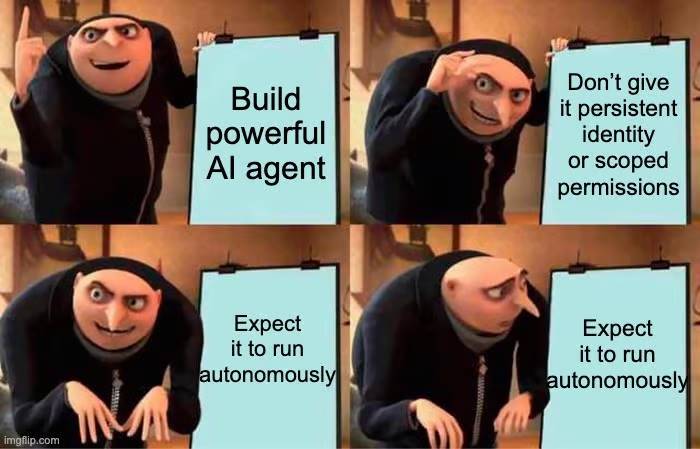
- Autonomous Payments
In theory, agents can hold wallets, but in reality, they are often trapped in the "hell" of fintech: every payment requires permission from platforms like Stripe, as if asking for parental approval (Stripe has previously explored agent-driven payments). What agents truly need is a wallet-native payment channel that allows them to pay per API call, subscribe to data streams, and execute microtransactions without any human intervention. Such infrastructure is almost non-existent today.
- Programmable Governance
Trust also concerns rules. How should breaches of contract or substandard services be handled? Who will arbitrate and enforce? In human society, we have courts and customer service. But agents cannot turn to customer service. What they need is programmable guardrails and enforceable agreements, with all rules enforced by code.
Almost all developers of agents have faced this dilemma. When you are passionately trying to create a trading agent or an on-chain research assistant, you quickly hit a wall:
How to grant it spending permissions while ensuring "security and control"?
How to enable it to autonomously interact with other services?
How to prove that it has indeed completed the claimed work?
The current situation is that developers can only rely on makeshift wallet solutions and identity processes to barely maintain functionality, while praying that the system does not collapse. The agent economy cannot scale on such a fragile foundation. We urgently need a new infrastructure that makes trust a native, programmable capability, freeing developers from the tedious work of reinventing the wheel.
A Trading Layer Built for AI Agents
What Kite is building is precisely such a trading layer tailored for the Agent Internet.
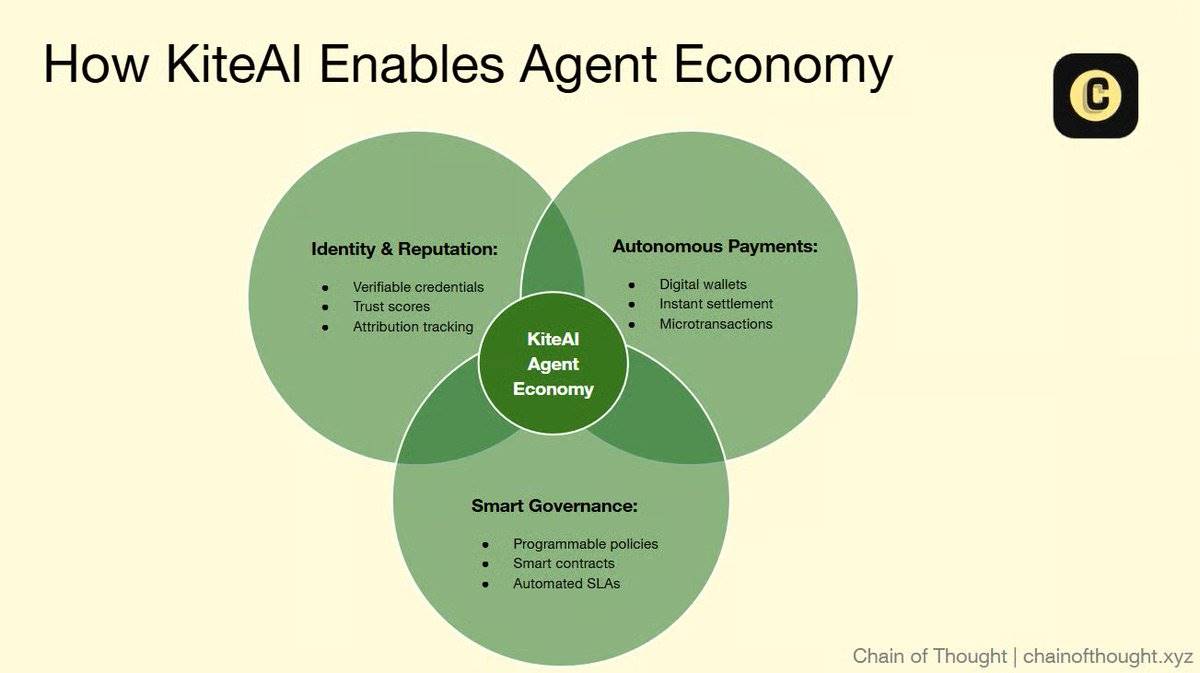
At the core of its technology stack is Kite AIR (Agent Identity Resolution), a programmable trust framework that empowers agents with the following capabilities:
Authentication: Obtaining identity through a persistent, verifiable "Agent Passport."
Transactions: Using stablecoins like USDC and PYUSD for native payments.
Execution: Executing rules through programmable service level agreements (SLA) and policy modules.
Kite's innovation lies in the fact that it does not "patch" existing financial facilities but directly integrates trust into the protocol's DNA. Each agent is granted a cryptographically verified "passport," which details its creator, scope of permissions, spending rules, and usage restrictions. Every interaction it executes is settled on-chain, leaving a publicly transparent audit trail, completely eliminating reliance on centralized intermediaries. Accessing external services or APIs is strictly controlled by smart contracts, which encode prices, permissions, and contingency plans in advance.
This design makes the independent operation of agents a reality.
More importantly, Kite's design lowers the barrier to entry for cryptographic technology, allowing mainstream developers to easily get started, which is the key to achieving large-scale applications in Web3. Developers do not need to learn Solidity or manually manage private keys; the platform provides a complete set of SDKs, templates, and pre-built modules, enabling them to easily register agents, configure rules, and deploy them online.
Underlying Secrets: How Kite Provides "Verifiable Trust" for Agents

Source: KiteAI Docs
First Pillar: Cryptographic Identity and Authorization
Most AI agents today are "stateless scripts," unable to verify their creators or limit their permission boundaries. Kite addresses this issue with "Agent Passports": a cryptographic verifiable credential whose rules are enforced at the protocol level through mathematical algorithms.
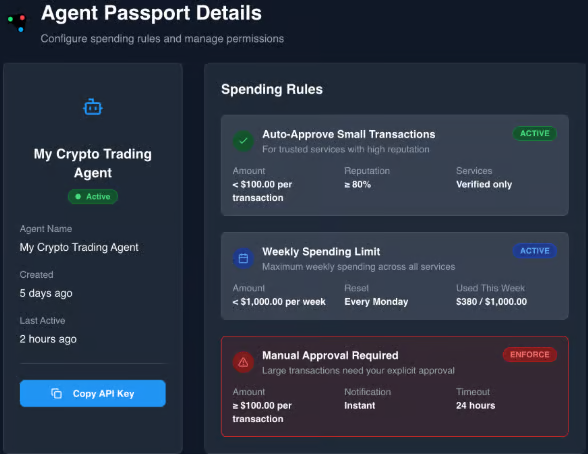
Each "Agent Passport" precisely encodes:
Spending limits and budget caps
Authorized service providers and API whitelists
Time-bound operational windows
Multi-signature approvals for high-value operations
This transforms agents into native economic participants. Users can maintain ultimate control while providing fine-grained, auditable authorizations to agents. For example, if you authorize a travel agent with a $2,000 hotel booking limit, this cap will be embedded in its cryptographic DNA, and it cannot be breached under any circumstances, including accidents.
The result is straightforward: agents can only do what they are authorized to do, no more, no less, with restrictions enforced by code.
This identity and authorization layer is key to making autonomy a reality. When each agent has a persistent, verifiable identity with clearly defined permissions, service providers can confidently interact with them, payments can be executed automatically, and tasks can flow smoothly between agents, all under transparent and enforceable rules. The identity issue is a bottleneck hindering the scaling of autonomous collaboration, and the "Agent Passport" is one solution to this problem.
Second Pillar: Programmable Governance and Policy Execution Constraints
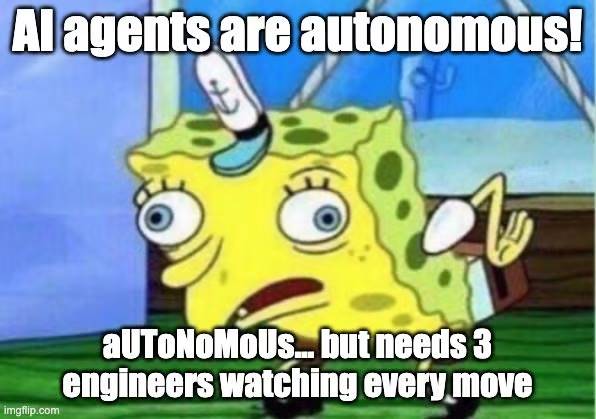
We cannot allow AI agents to act recklessly; they need rules to constrain them. Some of these rules must be rigid, while others require a degree of flexibility. Current AI lacks both, relying heavily on continuous human supervision.
Kite replaces "normal human oversight" with programmable governance. This rule engine deeply embeds safety guardrails into the core operational logic of agents and grants them the ability to make adaptive adjustments when necessary. Smart constraints are inherent.
Kite's governance system operates on two key levels:
- Context-Aware Control
Kite's architecture helps developers easily build intelligent monitoring systems that effectively enforce operational boundaries. The system can proactively identify abnormal spending behaviors, verify counterparties' identities before transactions, and determine whether an agent's actions deviate from its authorized intent. If an anomaly is detected, such as a shopping agent attempting to purchase luxury items outside its authorization, the system will immediately halt the action.
- Fail-Safe and Reporting Mechanism
For extreme situations, Kite has designed automated safety mechanisms. A "circuit breaker" can force an agent to pause if its behavior is abnormal or exceeds operational thresholds. When an agent encounters an unknown situation that cannot be handled safely, the system will return decision-making authority to the human owner, along with a complete audit trail and handling suggestions.
Programmable governance transforms agents from "fragile demonstrations" into trustworthy executors.
Third Pillar: Transparent Attribution and Audit Trail
Kite records every API call, payment, inference, and policy trigger in an immutable manner on-chain. This establishes a fully trustworthy historical record of agent behavior that can be relied upon by counterparties, users, and service providers.
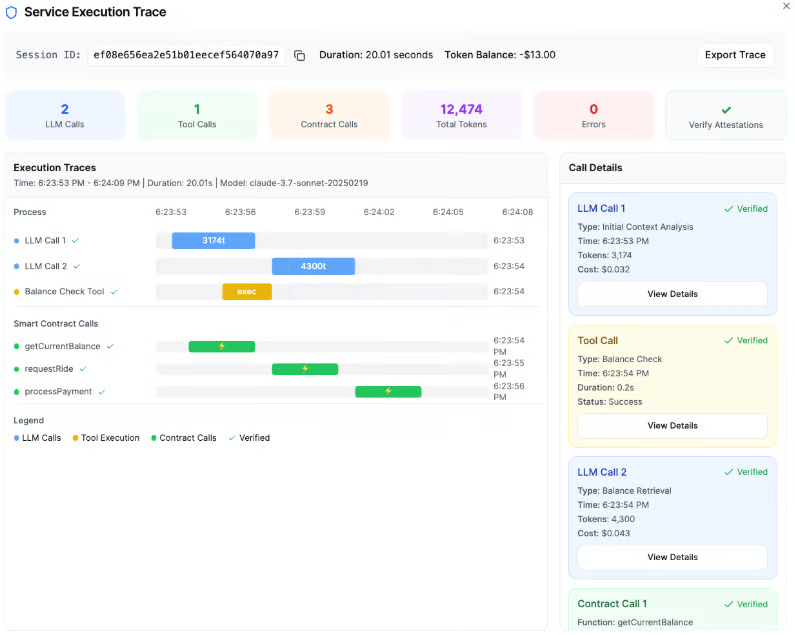
Source: KiteAI Platform Demo
To protect privacy, Kite employs zero-knowledge auditing technology. This allows users and counterparties to verify whether an agent is compliant without exposing any sensitive data. For example, a trading agent can prove it strictly adhered to investment rules without disclosing specific holding details.
This deep transparency answers all core questions:
Is my agent acting entirely according to my authorization?
If a task fails, can I trace it back?
More importantly, it creates a compounding advantage. Over time, these audit records will drive continuous optimization of the system. Agents learn from historical behavior, service providers become more accountable due to the complete audit trail, and users choose agents based on "verifiable history" rather than "marketing rhetoric."
Transparency thus transforms into a true competitive barrier.
Built-in Safety Net: Dispute Resolution and Insurance
Unexpected events are inevitable. Services may be interrupted, and agents can make mistakes. Kite embeds safety mechanisms at the foundational level to ensure disputes can be resolved automatically, and no one will bear the cost of unfulfilled services.
All transactions are conducted through programmable escrow. Funds are locked until the agreed delivery conditions are met. If a task fails, the funds are automatically returned. If there is a disagreement between the parties regarding task completion, Kite's arbitration layer will intervene, making a ruling based on on-chain audit records and preset rules, and enforcing it on-chain.
For more complex situations such as fraud or partial fulfillment, Kite's architecture also supports the integration of decentralized insurance modules. Existing ecological protocols have shown strong interest in this. Insurance claims can be automatically triggered based on verifiable data, requiring no human intervention.
These safety mechanisms elevate the agent economy from a fragile experiment to a robust system capable of handling the complexities of the real world. Agents can trade with confidence, knowing that failures and disputes have predefined solutions.
Thus, a complete industry landscape operated by agents (such as ride-hailing, logistics, research, and even financial transactions) begins to become tangible, with agents autonomously coordinating and efficiently fulfilling tasks without human supervision.
From Infrastructure to Seamless Integration: Simplifying Development
If Kite's trust primitives are too complex to use, they will be of no value. Therefore, one of Kite's core philosophies is to make developers almost unaware of the existence of these underlying facilities.
Kite provides developers with the following conveniences:
SDK: Easily register agents, assign permissions, and integrate services through Python and familiar APIs.
Smart Contract Templates: Covering common scenarios such as streaming payments, fund custody, and SLA execution, allowing developers to focus on business logic without building underlying contracts from scratch.
Graphical Dashboard (provided by Kite modules and ecosystem developers): Allowing users to configure agent strategies, monitor operational status, and review audit logs through a graphical interface, without ever touching blockchain code.
Service Access Suite: Helping traditional Web2 platforms verify agent identities and automatically collect payments from them.
Kite's goal is to eliminate all unnecessary friction in the tech stack, enabling developers to focus entirely on the core design and logic of agents, while complex issues like identity, trust, and settlement are perfectly handled by the underlying facilities.
A Near Future: A New Uber Experience Driven by Agents
As Kite's infrastructure continues to improve, a future of freely collaborating agents is transitioning from a sci-fi concept to the next chapter in the evolution of the internet.
Let’s return to the earlier example about Uber. A user gives a command to their personal agent: "Help me book a ride from SoHo to JFK airport. Budget: $50. If I arrive early, give a $10 tip. Pay with USDC."
The user's personal agent immediately queries multiple verified ride-hailing agents (like UberAgent, LyftAgent) for pricing.
Each ride-hailing agent has a public reputation profile, including SLA history, user ratings, online duration, and payment reliability.
The personal agent selects UberAgent, then escrow the $50 budget into a smart contract and agrees on refund terms for lateness.
The vehicle arrives on time, the SLA is met, and the smart contract automatically releases the $50 fare plus a $10 tip to UberAgent.
If an issue arises (for example, the driver cancels the order), a backup plan is immediately activated: the escrowed funds are automatically refunded, the trust rating of the UberAgent provider decreases, and the insurance pool (prepaid by the user) covers the "lost work costs."
With the driving force of smart contracts, native wallet payments, and programmable agent governance, all of this will be completed autonomously, transparently, and verifiably.
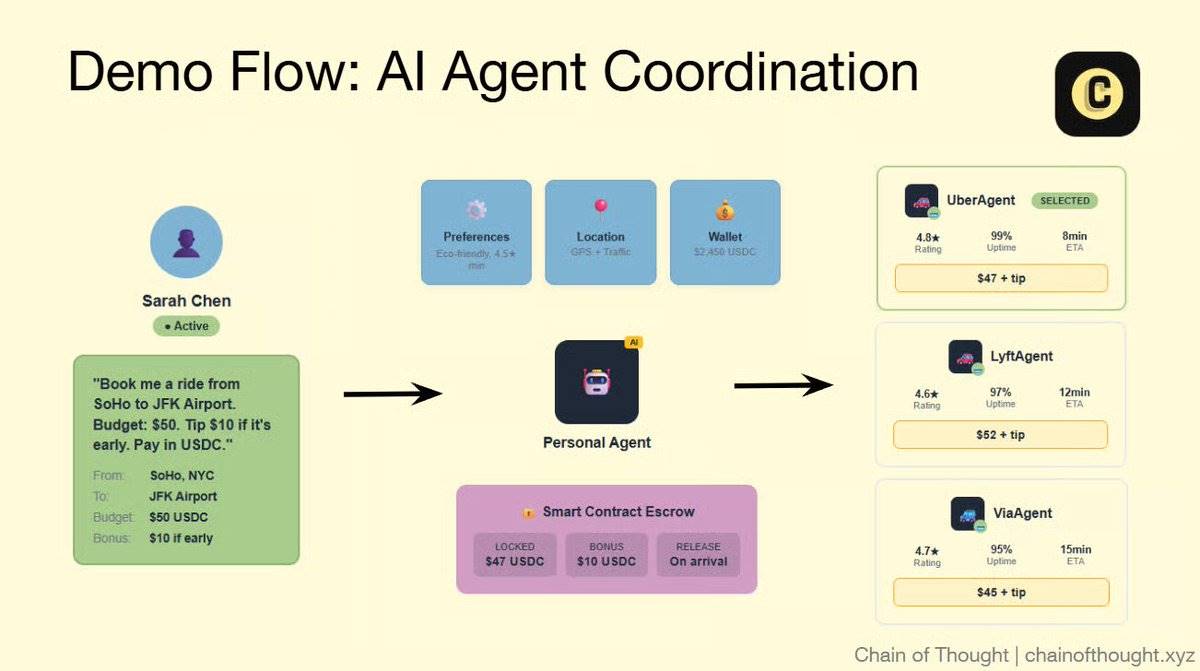
This is just one scenario.
Now, imagine the same collaborative layer applied to shopping agents on the Shopify platform, portfolio management agents that automatically rebalance through DEX agents, or medical health agents that obtain cutting-edge papers through medical research agents.
Soul-Searching Question 1: Why Must We Use Blockchain?
This question can stump even the top teams.
The answer is: because agents prioritize action over requests. They make transactions, pay bills, and call services in milliseconds, all without human intervention. No approval processes, no email communications, and no delays of "I need to report this for processing."
Traditional Web2 architectures cannot support this level of autonomy. API keys can be stolen, payment systems rely on manual KYC and approvals, and commercial disputes get stuck in long customer service queues. When agents make decisions at machine speed, this outdated system will completely fail.
Collaboration among humans is already challenging; under the scale of agents, existing collaboration models will completely collapse. Trust can no longer be an optional add-on; it must become the foundation of the entire system. Agents need a new track where every action can be proven, every transaction can be enforced, and every decision can be traced back for accountability.
Looking at today's technology, blockchain is the only system born to support this level of autonomous collaboration.

It grants agents five indispensable capabilities: enforceable agreements, continuous payments, portable identities, transparent public logs, and a borderless execution environment. Each capability replaces fragile, inefficient manual processes with deterministic code.
This is not "decentralization for the sake of decentralization," but because software that acts autonomously inherently requires a track that does not rely on external approvals.
Soul-Searching Question 2: Why Build a Dedicated L1 for AI?
Okay, even if we need blockchain, why start from scratch? Can't we just use Ethereum, Base, or Solana?
Because none of the existing general-purpose public chains are designed for the core needs of AI agents.
Their design intention is to serve human activities: wallet logins, large batch payments, token exchanges, etc.
In contrast, the behavior patterns of AI agents are fundamentally different; they generate massive, continuous, high-frequency low-value transactions: such as micro-payments for per-call usage, real-time status updates for streaming services, and dynamic strategy checks before each action. Even Solana, known for its high performance, struggles to handle the vast number of micro-interactions generated concurrently by millions of agents. If a $0.01 API call incurs a $0.05 network fee, then the entire economic model becomes untenable.
Kite's sovereign chain addresses this issue at the architectural level. Its state channel system can efficiently process the vast majority of agent interactions off-chain while ensuring final secure settlement on-chain, balancing efficiency and trustlessness. This allows the system to handle thousands of micro-transactions per second while guaranteeing finality. The main chain only intervenes at critical moments, such as creating/closing channels and resolving disputes, significantly reducing the burden.
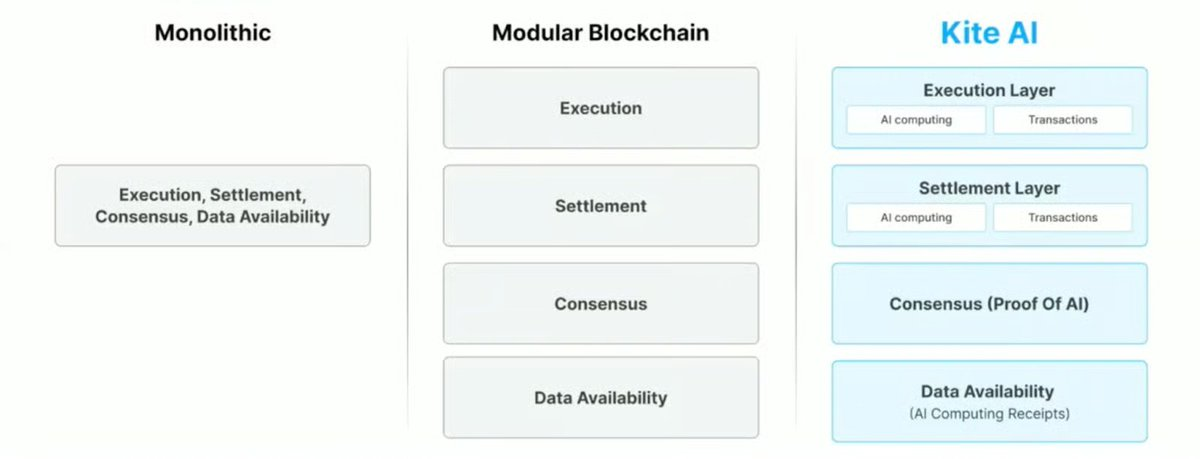
Source: KiteAI Docs
AI-Native "Base Primitives"
Kite replaces traditional consensus mechanisms with Proof of Artificial Intelligence (PoAI): a mechanism that tracks and rewards agent contributions based on measurable impact.
When an agent successfully completes a task, the value it creates is precisely distributed among the data providers, model builders, infrastructure operators, and service nodes involved. High-quality contributors receive greater rewards, thereby achieving incentive compatibility by design.
In the Kite network, each agent operates through decentralized identifiers (DIDs) and verifiable credentials (VCs). Identity authentication and permission management are completed on-chain, without any external verification layer.
The collaboration model among agents is also reshaped at the economic level. Thousands of micro-transactions can be aggregated for batch settlement. Subscription models, usage-based billing, and programmable fee-sharing mechanisms collectively build a clear and predictable cost model. Value attribution thus becomes unprecedentedly precise and automated.
All of this forms an infrastructure layer that views agents as "software-first economic entities." This is a truly native protocol that understands AI.
(More details on token economics and incentive design will be disclosed by the team in the coming weeks.)
## Kite's Early Development Momentum and Demand
Kite AI adopts a modular system design. Each module is an independent execution environment focused on a specific domain, with its own rules and incentive mechanisms, yet interconnected with the entire Kite network.
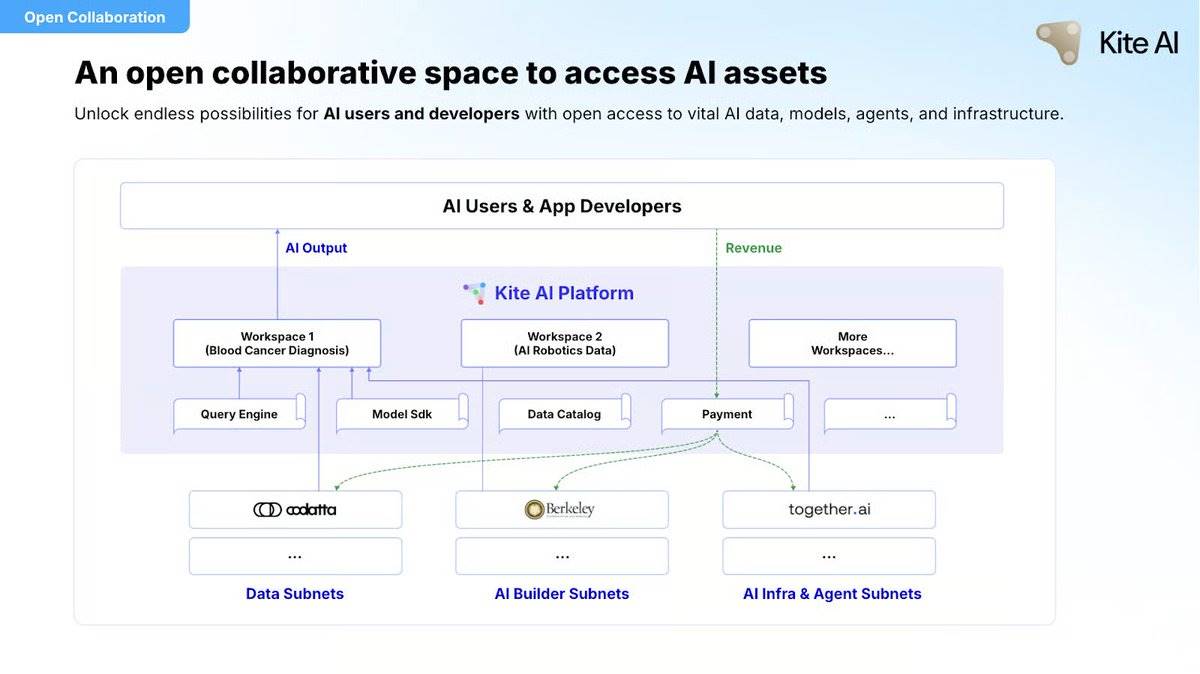
This design brings three core advantages:
Permissionless collaboration: Developers and data providers can freely create or join modules without restrictions from any centralized authority.
Transparent contributions: Every contribution, from data labeling and model fine-tuning to inference services, can be clearly tracked and attributed on-chain.
Decentralized governance: Each module is jointly decided by its stakeholder community, ensuring a high degree of alignment between long-term goals and contributor incentives.
For example, one module may focus on managing medical imaging datasets, while another provides computing power for physical simulations. They develop independently but share Kite's powerful infrastructure.
Codatta is the first full-stack data protocol integrated as a module into the Kite AI ecosystem, bringing over 500 million cross-domain labeled data points covering multiple industries such as healthcare, robotics, and cryptocurrency.
Module 01: Codatta
As a module of Kite, Codatta achieves seamless integration with other services while maintaining autonomous operation. Agents can easily obtain datasets, initiate labeling tasks, or evaluate model outputs from Codatta through simple function calls. In Kite's app store, Codatta's services are displayed alongside other AI tools, making it easy for developers to discover and integrate.
The most exciting use case in this collaboration is: using annotated blood smear datasets to power early blood cancer detection AI models. These agents are saving lives in the real world, not just engaging in token transactions.
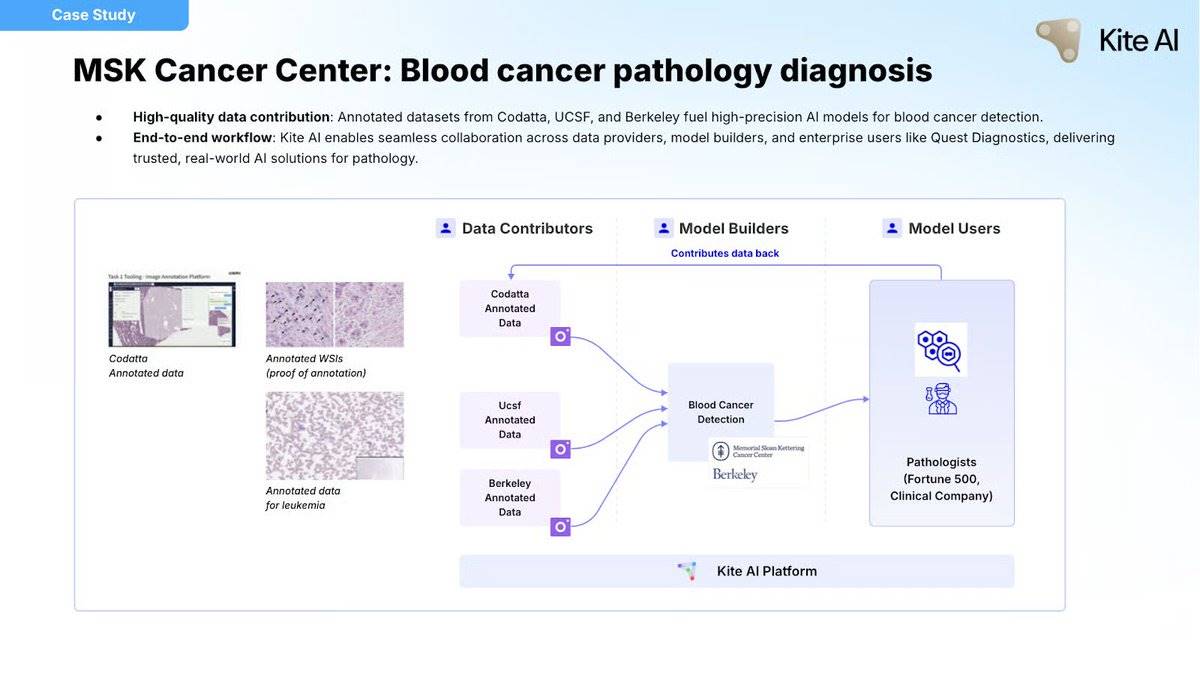
Kite's blockchain is deeply optimized for AI-scale computations, ensuring that the system runs smoothly even during peak data labeling and retrieval periods, which is crucial for Codatta's real-time workflows. The royalty mechanism is embedded in the protocol, automatically recording each time an agent uses a dataset and allocating earnings to data contributors.
Codatta is the first strong proof of Kite's vision for an open AI economy, but this is just the beginning. In the future, Codatta and Kite will work together to enter more verticals, introduce more functional modules, and jointly build a powerful data layer for autonomous AI that is composable and incentive-compatible.
Kite's Testnet Progress
Product-market fit (PMF) is not achieved through "points" or leaderboards. It is truly achieved when real users and developers choose to stay and continue using your product without any material incentives.
Kite's core Layer 1 has had its testnet live since early 2025. Although the complete agent toolchain is still being gradually rolled out, this has not affected the community's enthusiasm.
Testnet v1: Aero
The first phase, Aero, is aimed at general users, providing a no-code interface for interacting with AI agents developed by the Kite team. This phase adopted lightweight incentive measures.
During Aero, Kite released several internal demo agents, including the ecosystem guide The Professor, the fraud detection agent Sherlock, and the market-tracking Crypto Buddy. Users interact with them through a simple chat interface, and each command triggers real reasoning, attribution, and reward distribution on-chain.
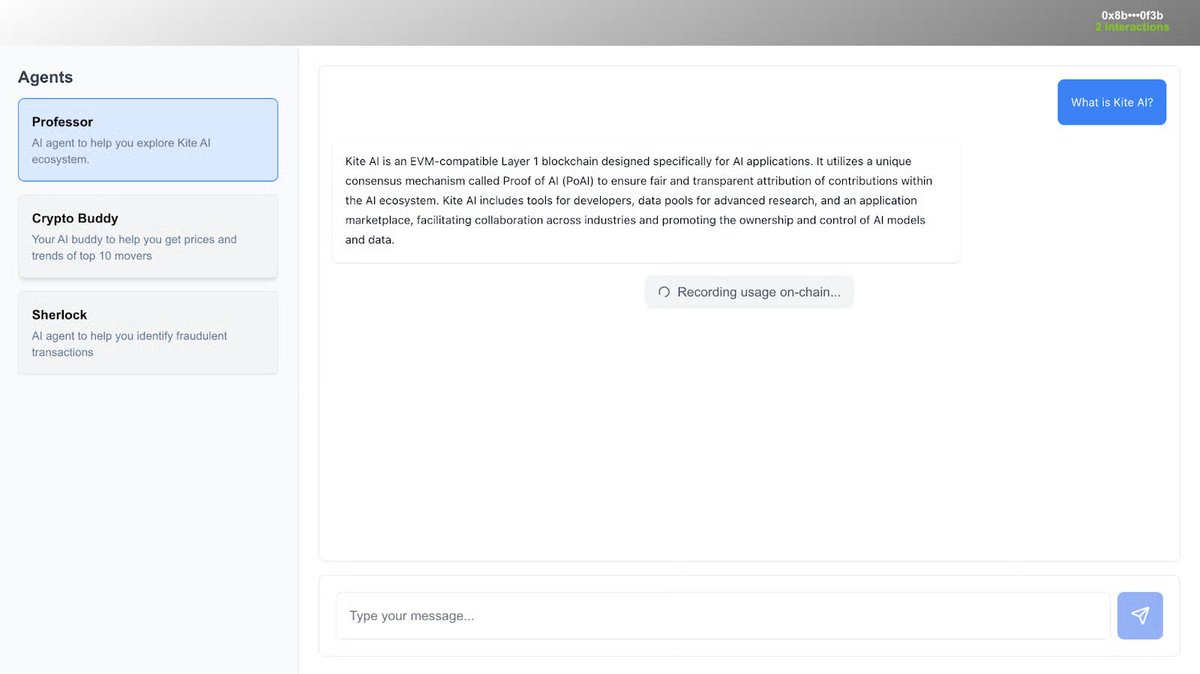
Source: KiteAI Aero Testnet
This initially validated that Kite's agent economic cycle is real and viable:
Over 1.2 billion total agent calls processed.
Cumulative users exceeded 53 million, with over 100,000 new users on peak days.
Over 30 million on-chain transactions, maintaining stable weekly growth.
Daily peak interactions exceeded 20 million, with over 200,000 daily active users and over 100,000 first-time AI users.
The vast majority of transactions stem from AI agents executing tasks, generating reasoning, and recording attribution, which aligns perfectly with the design intent of the testnet.
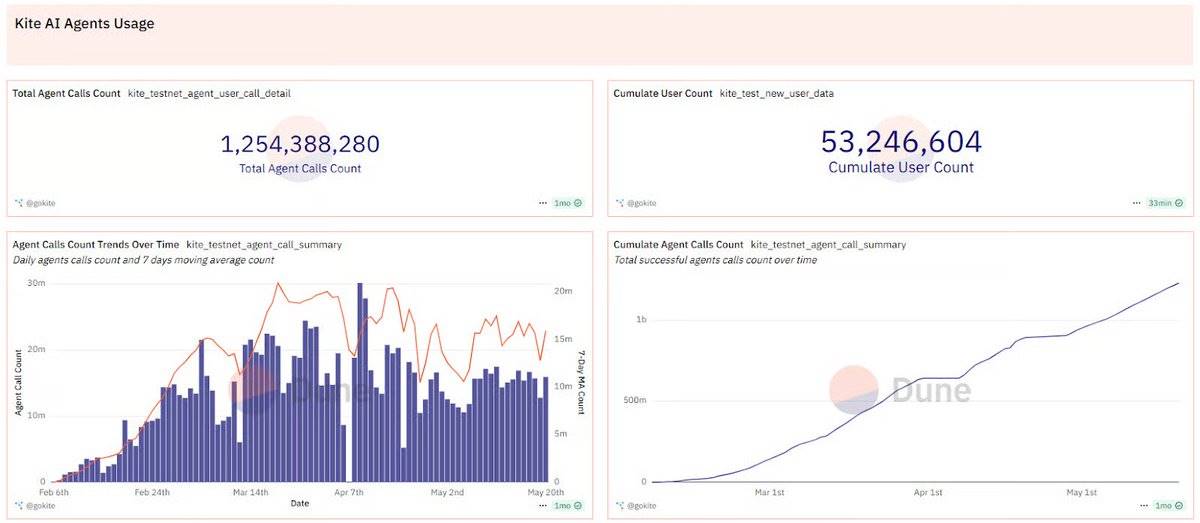
Source: Dune
Testnet v2: Ozone
In July 2025, the second phase, Ozone, launched, bringing significant upgrades: universal accounts, social logins, account abstraction, staking features, and the first batch of agents from ecosystem partners.
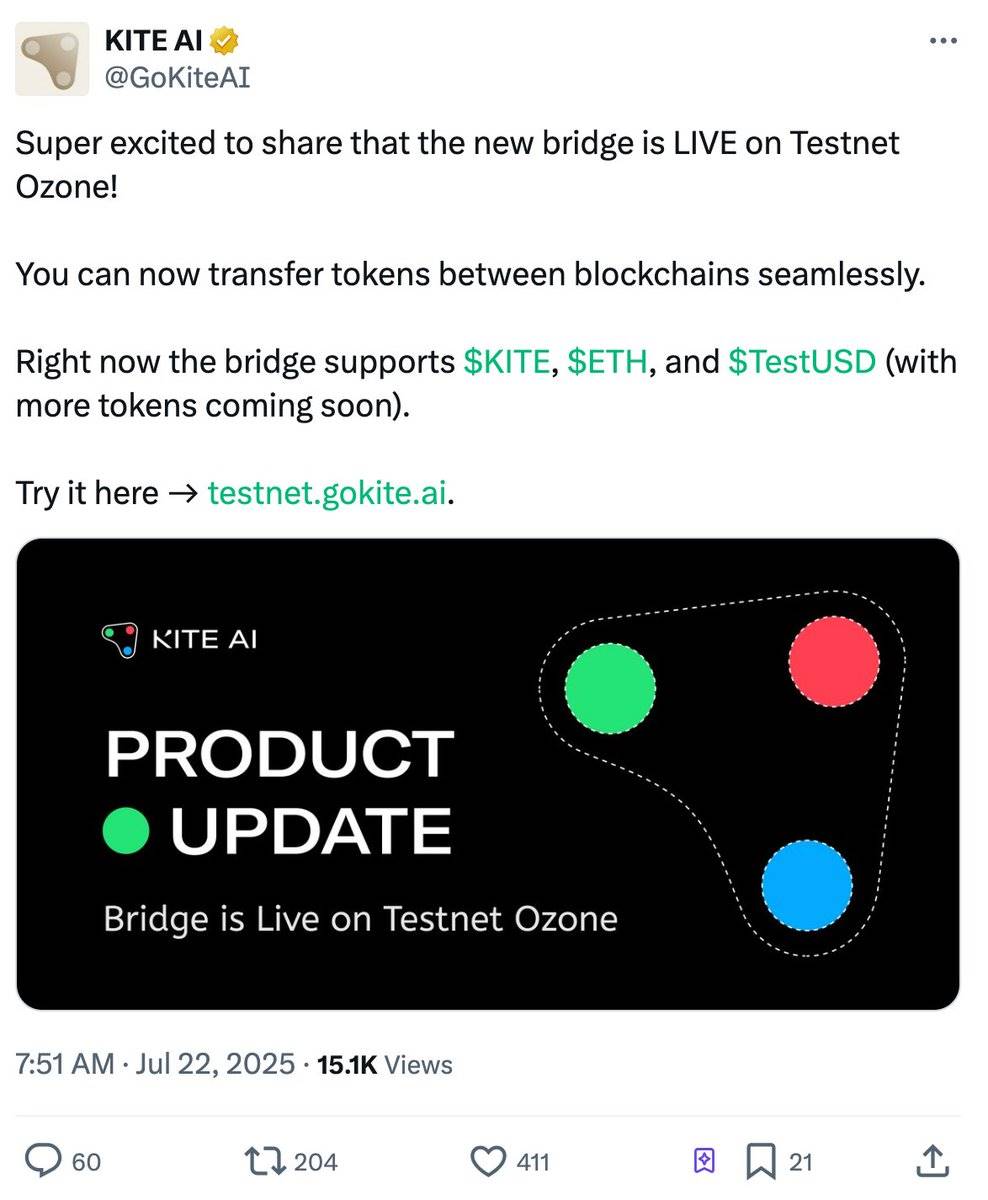
More importantly, the participants in the ecosystem are no longer limited to Kite's official team.
For example, AIVeronica from Animoca Brands (claimed to be "the world's first and largest AI Game Master") has launched in early form on the Kite testnet, along with several "personality dialogue" agents based on immersive NPC prototypes (such as Zane and Vyn).
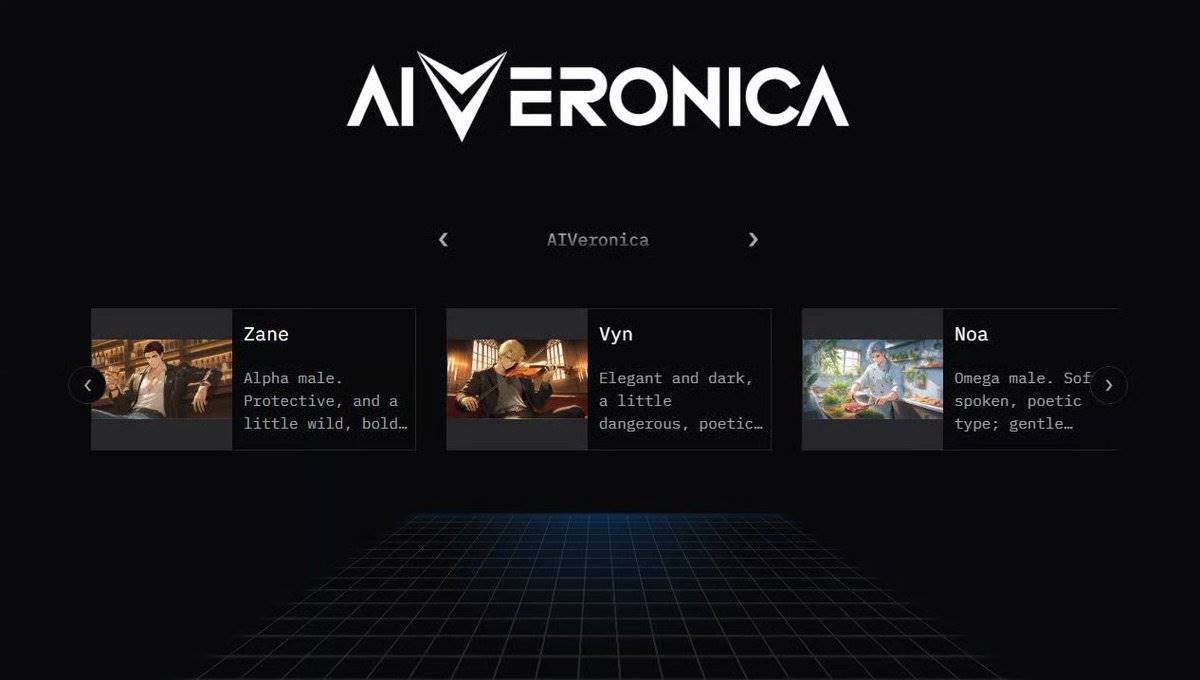
Agents from more partners like Bitte and BitMind are expected to join in subsequent phases, further highlighting Kite's positioning as a cross-domain, multi-developer platform.
Early data from the Ozone phase is impressive:
Over 509 million agent calls processed in a few weeks
13.4 million new unique users added
Daily interaction volume stabilized at tens of millions
Millions of NFT badges minted, reflecting the high engagement enthusiasm of early users

Source: Dune
Testnet v3
Testnet v3 is in the planning stage and is expected to launch at the end of August, introducing multi-signature wallets, fiat deposits and withdrawals, cross-chain bridges, token exchanges, staking mechanisms, and airdrop infrastructure. All of these will lay the groundwork for the official mainnet release in the fourth quarter.
As the public testing progresses steadily, Kite is also refining its core tech stack for developers and enterprise partners (currently by invitation only). The Kite agent app store helps teams easily publish agents and commercialize them; Kite Passport addresses identity, permissions, and programmable payment issues; and Kite SDK integrates everything, allowing developers to conveniently incorporate agent services into their applications.
Next steps include: stablecoin payments, cross-chain settlements, e-commerce plugins, agent reputation scoring systems, and "Know Your Agent (KYA)" certification, among others. The list of features is long, but each new feature rollout is aimed at solidifying Kite's position as the preferred infrastructure in the AI collaboration space.
Since the launch of the Aero testnet, the team has made significant technical progress:
Token generation time reduced from over 15 seconds to 1.3 seconds
Inference throughput surged from 1 per second to over 450
Stability of attribution and accuracy of reward calculations significantly improved
This rapid ability to resolve bottlenecks, optimize logic, and enhance user experience demonstrates the team's determination and capability to achieve production-level scalability before the mainnet launch.
## Kite's Business Prospects
Where will future demand come from?
The activity level of the testnet indicates that users are curious about blockchain-native AI agents. However, curiosity will eventually fade; true, sustainable demand must stem from strong economic incentives.
Three Core Value Propositions
Kite's core competitive advantage lies in its ability to create new economic opportunities that traditional technologies cannot achieve, specifically the commercialization, composability, and liquidity of AI assets.
Monetizable Open AI Market: In the existing AI architecture, value is often captured by top-tier platforms, which act like "toll booths" taking most of the profits. Kite's attribution engine can accurately track and reward the true creators of value. For example, a medical research institution's dataset can automatically generate income each time it is used to improve the diagnostic accuracy of a medical agent. This pay-per-use model, rather than the traditional licensing model, makes open contributions economically viable for the first time.
More Powerful AI Module Ecosystem: Developers can assemble their agents like building blocks using independent modules from different providers, each with clear pricing and verifiable performance metrics. A financial advisory agent can integrate A company's fraud detection module, B company's macroeconomic signal module, and C company's risk analysis module. Each module can earn revenue based on its contribution, with better performance leading to higher income. This naturally creates a virtuous cycle of competition, encouraging innovation and high-quality delivery.
Vibrant DeFi Economy: Thanks to its self-built Layer 1, Kite can deeply embed DeFi primitives into the system. High-quality AI services can be tokenized, staked, and traded, and the revenue streams they generate become investable assets. Capital will thus flow more efficiently to truly valuable innovations.
Ecosystem Flywheel: From "Single Agent" to "Real AI Economy"
Kite's strength lies in the fact that these value propositions can mutually reinforce each other, creating powerful network effects.
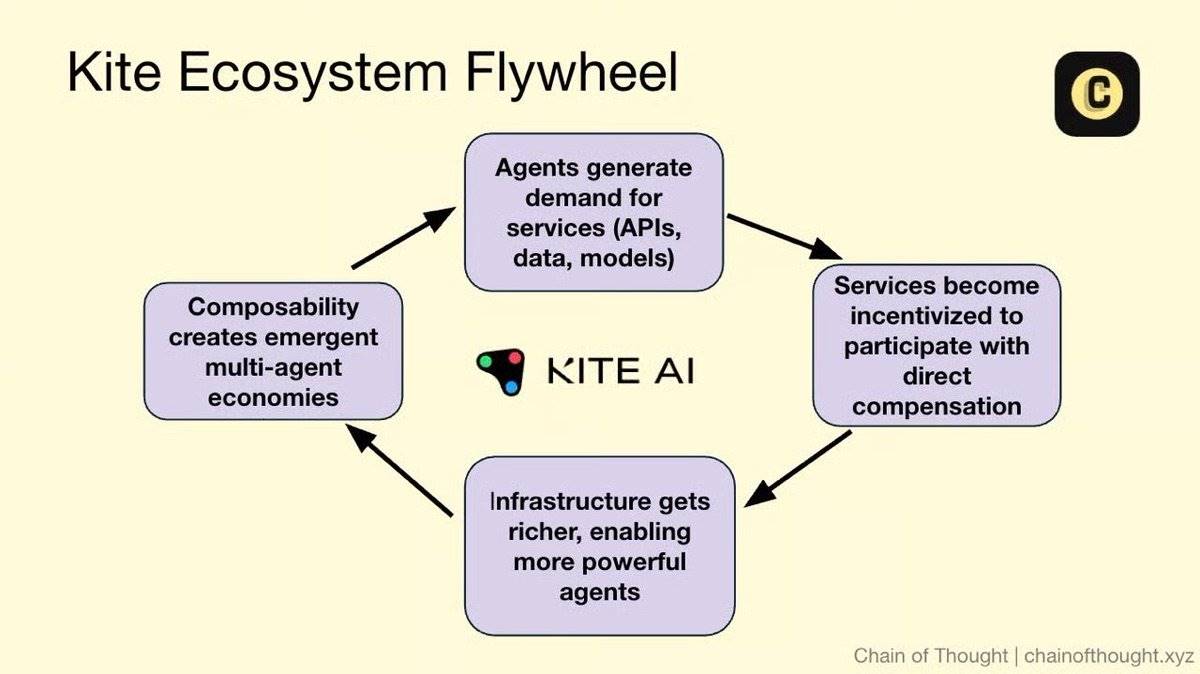
Agents → Stimulate Demand for Services
The operation of any agent relies on resources: data, models, APIs, and connections to the real world. In Kite's system, these resources can all become commercializable modules:
Weather APIs can charge agents per call
Dataset providers can license based on query volume
Trading signal bots can offer pay-per-use subscription services
Agents can settle with service providers in real-time, with verifiable SLAs as guarantees. This opens up a new commercialization path for all service providers: revenue no longer relies on advertising but comes from a direct, programmable reward mechanism—triggered by agent usage behavior, verified by smart contracts, and settled in stablecoins.
Services → Incentivize More Participants to Join
As the services connected to Kite become increasingly rich, the economic returns for joining this network also rise:
Shopify merchants can receive new orders from shopping agents
Data providers can earn continuous passive income from various AI assistants
Many niche but efficient models can be called and paid for by thousands of autonomous applications
This will create sustainable revenue models, incentivizing more high-quality service providers to join and driving the ecosystem's growth.
Infrastructure → Empower More Powerful Agents
As the service ecosystem becomes richer and easier to access, the value and feasibility of creating agents also soar. Developers no longer need to manually write integration code for every API; they can confidently choose services in the ecosystem that are verified, with clear pricing and service terms. Agents can easily link multiple services together to collaboratively complete complex tasks, ultimately evolving into fully functional applications.
A powerful growth flywheel is thus formed: More quality services → Stimulate stronger agents → Generate more usage → Create more revenue → Attract more quality services.
This is the essential path from the tool value of a single agent to the economy of multi-agent collaboration.
This will also position Kite as the coordination layer of the next generation of the internet—a network where AI agents collaborate globally without permission and continuously create value.
Team and Funding
Co-founder and CEO Chi Zhang holds a PhD in AI and Statistics from the University of California, Berkeley, with a research focus on explainable machine learning. This technical background is now reflected in Kite's core architecture: providing transparent, verifiable attribution for autonomous systems. Her career is both comprehensive and diverse, with practical experience in high-risk applications of AI for cancer diagnostics at Gilead, as well as product leadership roles at dotData (AutoML) and Databricks, accumulating rich experience in managing large-scale data pipelines. This rare combination of deep AI research and real-world product execution capability is essential for building a grand and technically intricate project like Kite.
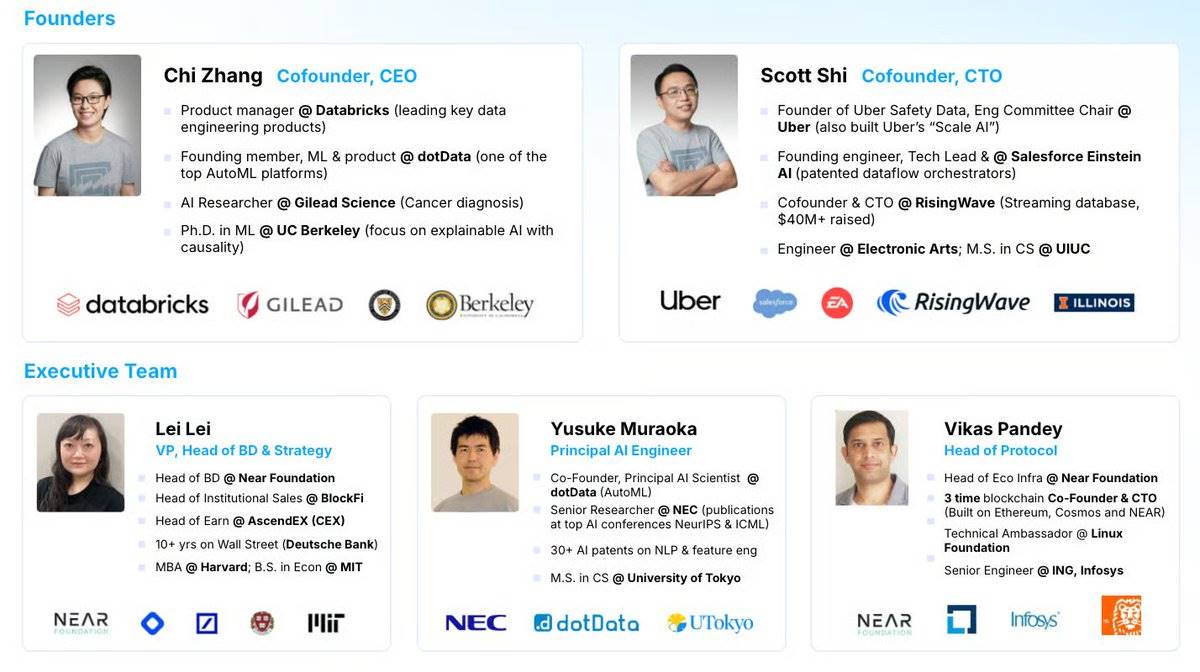
Co-founder and CTO Scott Shi is a top technical architect who has led the construction of AI infrastructure at several tech giants with the densest data globally. He previously led the engineering team for Salesforce Einstein, where he created a patented orchestration system for managing AI workflows across business data. At Uber, he built the company's safety analytics platform from scratch, processing billions of records to generate regulatory-compliant metrics. He later co-founded the high-performance streaming data company RisingWave, further deepening his capabilities in handling large-scale real-time data.
Other team members also have strong backgrounds, gathering talent from Alibaba, Uber, eBay, Salesforce, McKinsey, PayPal, and NEAR, with deep expertise in Web2 scaling, AI productization, enterprise compliance, and Web3 infrastructure, complementing each other's strengths. Overall, this is a top-tier team with balanced expertise in the intersection of AI and Crypto.
Since its inception, Kite AI has attracted the attention of several top AI and strategic investment institutions, with investors including PayPal Ventures, General Catalyst, 8VC, Vertex Ventures, Samsung Next, Alumni Ventures, HashKey Capital, Hashed, Animoca Brands, SBI US Gateway Fund, LayerZero, Avalanche Foundation, and Dispersion Capital.
Funding will be used to accelerate the implementation of Kite's infrastructure, support the development of new developer APIs like Kite AIR, and expand its service integration network.
Our Thoughts
#1: Real-World Use Cases Require Real-World Partners
For Kite to become the transaction layer for real-world agents, having only AI agents and crypto infrastructure is far from sufficient; it must embrace real-world services. I mean services that people actually use in their daily lives: Shopify merchants, fintech APIs, food delivery platforms, SaaS tools, streaming content, and travel booking engines. If agents cannot book rides or shop from real-world suppliers, their value will be significantly diminished, and Kite will risk becoming an isolated "crypto playground."
Therefore, in a sense, Kite is not just a technology platform but a powerful business development engine. The key to its success lies in:
Whether it can persuade mainstream Web2 service providers to deploy service contracts or register agents on Kite
Whether it can provide extremely simple graphical dashboards, plugins, and SDKs that allow non-crypto businesses to easily integrate
Whether it can completely encapsulate complex processes like wallets, KYC, and stablecoins through familiar APIs
Whether it can offer enterprise-grade billing, risk control, and SLA solutions
To fully unleash its potential, Kite must become the simplest and most efficient entry point for the traditional business world to embrace the "agent economy." A deep integration with Shopify, Doordash, or PayPal could bring demonstration effects and user growth that far exceed any technical milestone.
Kite is facing a historic opportunity: to become the bridge connecting AI agents with the existing internet world. This requires it to think of itself as a "partner company," rather than just a "protocol."
#2: Similarities and Differences with Bittensor
In a recent report by Coinbase Ventures, Kite and Bittensor are both categorized under the "decentralized intelligence and collaboration" track.

Source: Coinbase Ventures
Both projects are making a bold architectural bet: to build a crypto-native network that allows providers and consumers of AI services (agents) to collaborate freely on-chain and receive incentives. Bittensor pioneered this paradigm through its subnet model, while Kite aims to expand it into a broader agent-based economy. Both share similar goals: achieving open participation, transparent incentives, and on-chain accountability through enforcement.
Of course, Kite's implementation path is entirely different.
The core of Bittensor is the Yuma consensus, which relies on mutual evaluation of model outputs between nodes to allocate TAO token rewards. Essentially, this is a reputation game based on peer review. In contrast, Kite employs Proof of AI, where value attribution is directly linked to the final execution results of tasks. Agents complete verifiable work, and the value they create is distributed among all contributing nodes, such as data, models, and infrastructure.
Bittensor's success has already demonstrated that a well-designed incentive flywheel, once activated, can unleash tremendous energy: over 100 subnets, more than $60 million in token incentives per month, and a large, active community of contributors. Kite hopes to trigger a similar growth momentum, but its foundation is real agent transactions, rather than mere AI inference.
Bittensor's early development trajectory offers valuable lessons: in which aspects the incentive mechanisms are effective, where the consensus mechanisms create bottlenecks, and how the economic model ultimately shapes network behavior. Kite has the opportunity to optimize based on this foundation and carve out its own path.
The next chapter of the internet will be written by software that can act autonomously and create value in their work.
#3: Developer Experience Will Determine the Success or Failure of the Ecosystem
The vast majority of AI engineers are not familiar with Solidity; they use Python, call REST APIs, and deploy models to hosted endpoints. If Kite wants to attract top agent developers, it must keep the complex crypto infrastructure "behind the scenes."
The Kite team is acutely aware of this. Their developer tool stack heavily utilizes SDKs, templates, and automation tools. Whether registering agents, configuring SLAs, or integrating payments, all can be accomplished through simple command-line tools or ready-made SDKs.
To achieve widespread adoption, crypto technology must become an "optional" feature:
Agent developers should not have to worry about token economics or governance details
Publishing an agent should be as simple as uploading a model to HuggingFace
Commercialization should be an out-of-the-box feature
The success of Stripe lies in perfectly encapsulating the underlying complexities of the payment settlement network, allowing developers to easily receive payments without needing to understand its internal workings. Kite needs to do the same for agents. When developers realize that Kite is the most convenient way to publish, manage, and commercialize agents, the real explosion will come, without any need for blockchain background knowledge.
Conclusion
Today's AI agents are like "self-driving cars stuck in a parking lot." They have the ability to think, but struggle to move when it comes to collaborating with the real world.
Kite is changing all of this. The tracks it lays will transform agents from passive tools into true economic participants with identity, incentives, and collaborative capabilities.
The project is still in its early stages, with an extremely ambitious vision. But the direction is undeniably correct.
The next generation of the internet will be driven by agents, and Kite is almost ready.
免责声明:本文章仅代表作者个人观点,不代表本平台的立场和观点。本文章仅供信息分享,不构成对任何人的任何投资建议。用户与作者之间的任何争议,与本平台无关。如网页中刊载的文章或图片涉及侵权,请提供相关的权利证明和身份证明发送邮件到support@aicoin.com,本平台相关工作人员将会进行核查。




